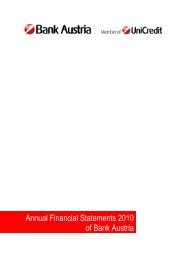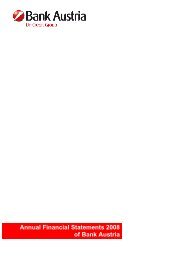Annual Financial Statements 2011 of Bank Austria
Annual Financial Statements 2011 of Bank Austria
Annual Financial Statements 2011 of Bank Austria
You also want an ePaper? Increase the reach of your titles
YUMPU automatically turns print PDFs into web optimized ePapers that Google loves.
Management Report <strong>of</strong> UniCredit <strong>Bank</strong> <strong>Austria</strong> AG<br />
Due to the challenging political and economic situation in Hungary,<br />
UniCredit Group has taken prudent risk mitigating measures and is<br />
actively monitoring the situation and its portfolio. UniCredit Group<br />
has also limited business via a watch list strategy. Apart from the<br />
current credit risk evaluation reflected in mark-to-market valuation<br />
an impairment is – in line with applicable accounting standards –<br />
currently not foreseen.<br />
While there is a small exposure to Hungary and Spain, the bank<br />
does not hold any Irish government bonds.<br />
The Italian risk is also centrally monitored and has also been<br />
adjusted via a watch list strategy, mainly focusing on UniCredit, tier<br />
1 banks and the sovereign within assigned counterparty credit and<br />
market risk limits.<br />
Own holdings <strong>of</strong> government bonds as <strong>of</strong> 31 December <strong>2011</strong><br />
Own holdings <strong>of</strong> government bonds as <strong>of</strong> 31 December <strong>2011</strong><br />
Country Classification Nominal amount Book value Market value<br />
<strong>Austria</strong> 1,580,000,000.00 1,543,481,597.89 1,684,262,750.00<br />
Fixed assets 1,189,700,000.00 1,150,441,404.57 1,279,780,805.00<br />
Current assets 390,300,000.00 393,040,193.32 404,481,945.00<br />
Italy 1,112,464,078.60 1,101,083,916.37 1,090,228,348.62<br />
Fixed assets 232,464,078.60 233,466,583.65 222,319,348.62<br />
Current assets 880,000,000.00 867,617,332.72 867,909,000.00<br />
Greece 368,137,724.55 93,473,952.51 93,473,952.51<br />
Fixed assets 338,137,724.55 87,298,452.51 87,298,452.51<br />
Current assets 30,000,000.00 6,175,500.00 6,175,500.00<br />
Croatia 92,215,735.70 89,764,280.88 88,915,455.76<br />
Fixed assets 10,000,000.00 10,056,125.12 9,207,300.00<br />
Current assets 82,215,735.70 79,708,155.76 79,708,155.76<br />
Belgium 80,000,000.00 79,989,953.81 83,382,000.00<br />
Fixed assets 80,000,000.00 79,989,953.81 83,382,000.00<br />
Current assets 0 0 0<br />
Portugal 70,000,000.00 69,953,324.73 45,500,000.00<br />
Fixed assets 70,000,000.00 69,953,324.73 45,500,000.00<br />
Current assets 0 0 0<br />
Romania 10,000,000.00 9,968,057.51 9,572,450.00<br />
Fixed assets 10,000,000.00 9,968,057.51 9,572,450.00<br />
Current assets 0 0 0<br />
Other Countries 21,941,022.62 21,777,023.69 21,710,208.40<br />
Fixed assets 21,941,022.62 21,777,023.69 21,710,208.40<br />
Current assets 0 0 0<br />
TOTAL 3,334,758,561.47 3,009,492,107.39 3,117,045,165.29<br />
Credit risk<br />
Net write-downs <strong>of</strong> loans and provisions for guarantees and<br />
commitments in <strong>2011</strong> continued to improve across all segments<br />
compared with the previous year. This development reflected<br />
significantly higher economic stability, especially in the first half <strong>of</strong><br />
the year, and the fact that the economic slowdown which started in<br />
the second half <strong>of</strong> <strong>2011</strong> did not yet have a strong impact.<br />
In the Corporate & Investment <strong>Bank</strong>ing segment (CIB), the decline<br />
in the number <strong>of</strong> new cases requiring corporate restructuring<br />
activities had a positive influence on additions to loan loss<br />
provisions. At € 128.2 m, net write-downs <strong>of</strong> loans and provisions<br />
for guarantees and commitments in this business segment were<br />
further reduced, by more than 20%, from the previous year’s level.<br />
In the Family & SME <strong>Bank</strong>ing segment (F&SME), net write-downs<br />
<strong>of</strong> loans and provisions for guarantees and commitments continued<br />
to decline even after the inclusion <strong>of</strong> the sub-segment comprising<br />
small and medium-sized businesses with a turnover <strong>of</strong> up to € 50<br />
m. Overall, the provisioning charge in this business segment<br />
amounted to € 157.5 m, an improvement <strong>of</strong> 25 % over the previous<br />
year which was mainly due to significantly lower additions to loan<br />
loss provisions in the sub-segments <strong>of</strong> Mass Market and Affluent<br />
customers. The additional write-down on foreign currency loans in<br />
these sub-segments was further increased to take adequate<br />
account <strong>of</strong> the risk associated with loans with final maturity. Quite<br />
generally, as in the previous year, a large number <strong>of</strong> additional<br />
advisory talks were held with customers in this segment in several<br />
waves in order to evaluate the new situation and the credit risk<br />
costs arising for the bank from this type <strong>of</strong> loan on a timely basis.<br />
At any point in time, the risk-focused presentation (credit line in €,<br />
utilisation in currency) shows the amount <strong>of</strong> the credit line originally<br />
granted to the customer, the currency fluctuation allowed for when<br />
the loan was granted, and the amount currently outstanding.<br />
In the CEE segment, net additions to loan loss provisions in<br />
UniCredit <strong>Bank</strong> <strong>Austria</strong> AG in <strong>2011</strong> amounted to € 232.6 m. Most <strong>of</strong><br />
this amount related to a provision for the guarantee given for the<br />
Kazahk loan portfolio to support the local subsidiary. Moreover, as<br />
in previous years, write-downs were made on CEE exposures<br />
booked in Vienna, especially in the Real Estate sub-segment.<br />
Credit risk methods and instruments<br />
Very important factors in the credit approval process are a detailed<br />
assessment <strong>of</strong> risk associated with each loan exposure, and the<br />
customer’s credit rating in particular. Every lending decision is<br />
based on a thorough analysis <strong>of</strong> the loan exposure, including an<br />
evaluation <strong>of</strong> all relevant factors. Following the initial loan<br />
application, the bank’s loan exposures are reviewed at least once a<br />
year. If the borrower’s creditworthiness deteriorates substantially,<br />
shorter review intervals are obligatory.<br />
For internal credit assessment in <strong>Austria</strong> and by <strong>Bank</strong> <strong>Austria</strong>’s<br />
banking subsidiaries in CEE, the bank uses various rating and<br />
scoring models – for calculating the parameters PD (probability <strong>of</strong><br />
default), LGD (loss given default) and EAD (exposure at default) –<br />
on the basis <strong>of</strong> models specifically developed for these purposes<br />
for the customer/business segments to be assessed, in line with<br />
the various asset classes pursuant to Section 22b <strong>of</strong> the <strong>Austria</strong>n<br />
<strong>Bank</strong>ing Act, the Solvency Regulation and Directive 2006/48/EC <strong>of</strong><br />
the European Parliament and <strong>of</strong> the Council <strong>of</strong> 14 June 2006<br />
relating to the taking up and pursuit <strong>of</strong> the business <strong>of</strong> credit<br />
institutions. There are country-specific or region-specific models<br />
(e.g. for corporate customers, private and business customers) and<br />
global models (e.g. for sovereigns, banks, multinational<br />
corporates). The assessment <strong>of</strong> a loan exposure is based on data<br />
from the respective company’s financial statements and on<br />
qualitative business factors.<br />
The various rating and scoring models provide the basis for<br />
efficient risk management <strong>of</strong> the <strong>Bank</strong> <strong>Austria</strong> Group and are<br />
embedded in all decision-making processes relating to risk<br />
management. They are also a key factor for capital required to be<br />
held against risk-weighted assets. Great attention is given to<br />
consistency in the presentation for supervisory purposes and the<br />
requirements <strong>of</strong> internal control.<br />
All internal rating and scoring systems are monitored on an<br />
ongoing basis. The systems are also subject to regular validation<br />
on an annual basis, including a review to verify if the rating/scoring<br />
system provides a correct representation <strong>of</strong> the risks to be<br />
measured. All model assumptions are based on multi-year<br />
statistical averages for historical defaults and losses, with<br />
appropriate attention being given to the potential impact <strong>of</strong><br />
turbulence in international financial markets.<br />
<strong>Bank</strong> <strong>Austria</strong> – <strong>Annual</strong> <strong>Financial</strong> <strong>Statements</strong> <strong>2011</strong> 200
















